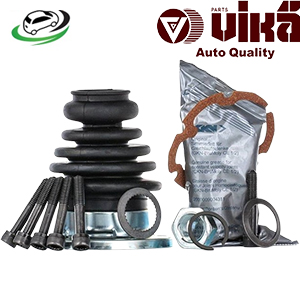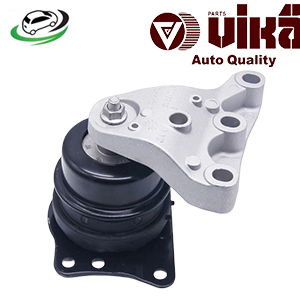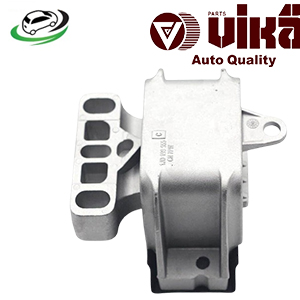-16%
Get Left Transmission Mount VW Golf IV – 1.8T/2.0/TDI/Jetta IV – 1.8T/2.0/TDI/New Beetle – 1.8T/2.0 1J0199555AJ
The transmission mount is a vital component of a vehicle’s drivetrain system. It secures the transmission to the vehicle’s frame and absorbs vibrations and shocks from the engine and transmission, providing a smooth and stable ride. Understanding the design, function, types, benefits, maintenance, and replacement of transmission mounts is essential for ensuring vehicle performance and longevity.
Design and Function
Design:
A typical transmission mount consists of the following components:
- Mounting Bracket: Usually made of steel or aluminum, the bracket attaches the transmission mount to the vehicle frame or subframe.
- Rubber or Polyurethane Insulator: The insulator is the core component of the mount, designed to absorb vibrations and shocks. Rubber is commonly used for its flexibility and damping properties, while polyurethane offers increased durability and performance.
- Bolts and Fasteners: These secure the transmission mount to the transmission and the vehicle’s frame.
Function:
The primary functions of a transmission mount are:
- Securing the Transmission: The mount holds the transmission in place, preventing it from moving excessively during vehicle operation.
- Absorbing Vibrations: The rubber or polyurethane insulator absorbs vibrations and shocks from the engine and transmission, reducing noise and ensuring a smooth ride.
- Maintaining Alignment: Keeps the transmission aligned with the engine and drivetrain components, ensuring efficient power transfer and reducing wear on connected parts.
- Enhancing Safety: Prevents the transmission from shifting or moving during acceleration, deceleration, and turns, contributing to overall vehicle stability and safety.
Types of Transmission Mounts
1. Rubber Transmission Mounts:
- Description: Made from high-quality rubber, these mounts are designed to provide flexibility and excellent vibration damping.
- Advantages: Offers a smooth and quiet ride, effective at absorbing vibrations, and generally less expensive.
2. Polyurethane Transmission Mounts:
- Description: Made from durable polyurethane, these mounts are designed to withstand higher stress and offer enhanced performance.
- Advantages: More durable and resistant to wear and tear, provides better support for high-performance or modified vehicles, and offers improved handling characteristics.
3. Hydraulic Transmission Mounts:
- Description: Incorporates a hydraulic fluid chamber within the mount to provide superior vibration damping and shock absorption.
- Advantages: Offers excellent vibration isolation, ideal for luxury vehicles, and provides a smoother ride.
4. Solid Transmission Mounts:
- Description: Made from solid materials such as steel or aluminum, these mounts are designed for maximum rigidity and performance.
- Advantages: Provides the most precise and direct connection between the transmission and the vehicle frame, often used in racing or high-performance applications.
Benefits
1. Vibration and Noise Reduction:
- Smooth Ride: By absorbing vibrations and shocks from the engine and transmission, transmission mounts contribute to a smoother and quieter ride.
- Reduced Noise: Effective vibration damping minimizes the transmission of noise to the vehicle cabin, enhancing occupant comfort.
2. Enhanced Stability and Safety:
- Secured Transmission: Ensures the transmission remains securely in place, preventing unwanted movement that could affect vehicle handling and safety.
- Improved Handling: Maintains proper alignment of the drivetrain components, contributing to better handling and stability during acceleration, braking, and cornering.
3. Longevity of Drivetrain Components:
- Reduced Wear and Tear: By maintaining proper alignment and absorbing vibrations, transmission mounts help reduce wear and tear on drivetrain components, extending their lifespan.
- Protection of Other Components: Prevents excessive movement that could damage other connected parts, such as the driveshaft, axles, and engine mounts.
Signs of worn out Transmission Mount
1. Excessive Vibrations
Symptom:
- Increased Vibrations: One of the most noticeable signs of a worn-out transmission mount is excessive vibrations felt through the vehicle, especially in the cabin.
Cause:
- As the mount wears out, its ability to dampen vibrations decreases, causing more vibrations to be transmitted from the engine and transmission to the vehicle’s frame and interior.
2. Clunking or Thumping Noises
Symptom:
- Unusual Noises: You may hear clunking, thumping, or banging noises coming from the transmission area, particularly when shifting gears, accelerating, or decelerating.
Cause:
- A worn-out mount can allow the transmission to move excessively, causing it to hit against other components or the vehicle frame, producing these noises.
3. Transmission Movement
Symptom:
- Noticeable Movement: Visible or felt movement of the transmission when driving, accelerating, or decelerating, especially when observing the transmission or engine bay.
Cause:
- A failing mount loses its ability to securely hold the transmission in place, allowing it to shift or move more than usual.
4. Difficulty Shifting Gears
Symptom:
- Hard or Jerky Shifting: Shifting gears becomes difficult or jerky, and you may experience trouble getting the vehicle into gear.
Cause:
- Misalignment caused by a worn-out mount can affect the linkage between the transmission and the shifter, leading to shifting problems.
5. Misalignment of the Drivetrain
Symptom:
- Misaligned Drivetrain Components: Drivetrain components may appear misaligned or out of place, leading to additional wear and potential damage.
Cause:
- A failing mount can cause the transmission to sit incorrectly, misaligning the drivetrain components and causing undue stress on connected parts.
6. Unusual Engine Movement
Symptom:
- Engine Rocking: Excessive engine movement or rocking when accelerating, decelerating, or during engine start and stop.
Cause:
- Since the transmission is connected to the engine, a worn transmission mount can lead to unusual engine movements as well.
7. Excessive Engine or Transmission Noise
Symptom:
- Increased Noise: Increased noise from the engine or transmission, often described as a growling, humming, or rattling sound.
Cause:
- As the mount wears out, it may fail to isolate engine and transmission noise, leading to more noise being transmitted to the vehicle cabin.
Maintenance and Troubleshooting
1. Regular Inspection:
- Visual Check: Inspect the transmission mount for signs of wear, such as cracks, tears, or separation of the rubber or polyurethane insulator.
- Physical Check: Check for excessive movement or play in the transmission mount by gently prying or moving the transmission to see if the mount is secure.
2. Symptoms of a Worn Transmission Mount:
- Excessive Vibrations: Increased vibrations felt through the vehicle, especially during acceleration or deceleration, can indicate a worn or damaged transmission mount.
- Clunking or Thumping Noises: Unusual noises coming from the transmission area when shifting gears or during sudden acceleration or braking.
- Transmission Movement: Noticeable movement or shifting of the transmission when driving, indicating that the mount is not securely holding the transmission in place.
- Difficult Shifting: Trouble shifting gears smoothly, which can result from misalignment caused by a worn transmission mount.
3. Replacement:
- Signs of Failure: Replace the transmission mount if you notice any of the above symptoms or visible signs of wear and damage.
- Replacement Procedure: Replacing a transmission mount typically involves lifting the vehicle, supporting the transmission, removing the old mount, and installing a new one. It is recommended to follow the manufacturer’s guidelines and torque specifications.
4. Professional Inspection:
- Alignment Check: A professional mechanic can check the alignment of the drivetrain components and ensure the transmission mount is functioning correctly.
- Comprehensive Inspection: A thorough inspection of the transmission mount and surrounding components can identify any potential issues before they lead to more significant problems.
Seasonal Considerations
1. Winter:
- Cold Weather Effects: Cold temperatures can cause rubber mounts to become brittle and less effective at absorbing vibrations. Inspect the mounts for signs of wear and replace if necessary.
- Salt and Corrosion: In regions where roads are salted during winter, inspect the mounts and surrounding areas for signs of corrosion and rust.
2. Summer:
- Heat Exposure: High temperatures can accelerate the wear of rubber mounts. Regularly inspect the mounts during summer months, especially in hot climates.
- Increased Stress: Long drives and heavy loads during summer travel can put additional stress on transmission mounts, making regular inspection and maintenance crucial.
Follow us on Facebook for more parts.



